This presentation is going to provide an overview of a project dedicated to the implementation of NICE (2016) guidelines (the guidelines developed by the National Institute for Health and Care Excellence) at the VEGA Medical Center.
Problem Statement and Purpose
- Objectives: project overview; discussion.
- Depression: major, relatively widespread health concern (CBHSQ, 2016; Petrosyan et al., 2017).
- VEGA Medical Center (Miami, FL): no guidelines!
- Project purpose: providing VEGA specialists with NICE (2016) guidelines.
The objectives of this presentation are to review the key information about the project, including its PICOT, methodology, and outcomes, and to start a discussion with questions about it.
The project is devoted to a rather significant healthcare issue that is also relatively widespread in the US and the world: depression. Depression has negative consequences for patients, decreases their quality of life, and increases healthcare spending (Petrosyan et al., 2017). Moderate and severe types of depression have been affecting about 6% of the US population in the past few years (CBHSQ, 2016). As a result, the quality of depression management is of great importance. One of the approaches to improving it consists of the use of high-quality, evidence-based guidelines (Petrosyan et al., 2017). However, within the settings of the project, which is a primary care center VEGA, no direct guidelines were employed prior to the beginning of the project. During the needs assessment, it was determined that the potential negative consequences of the issue were acknowledged by VEGA’s staff. Consequently, the purpose of the project was to rectify the problem and provide VEGA and its specialists with appropriate guidelines: NICE (2016) guidelines.

PICOT Question
In nursing staff at VEGA Medical Center (Miami, FL) (P), how does the implementation of NICE (2016) guidelines (I) affect (C) the accuracy of depression management (O) in the geriatric population within 8 weeks (T)?
The presented PICOT question was used for the project. As you can see, the population is the nursing staff of VEGA who adopted NICE (2016) guidelines as a form of intervention. No comparison was employed; instead, the nurses’ performance with respect to depression management in geriatric population was measured before and after the intervention. The intervention was adopted within the timeframe of 8 weeks, and the improvement of depression management quality was the desired outcome.
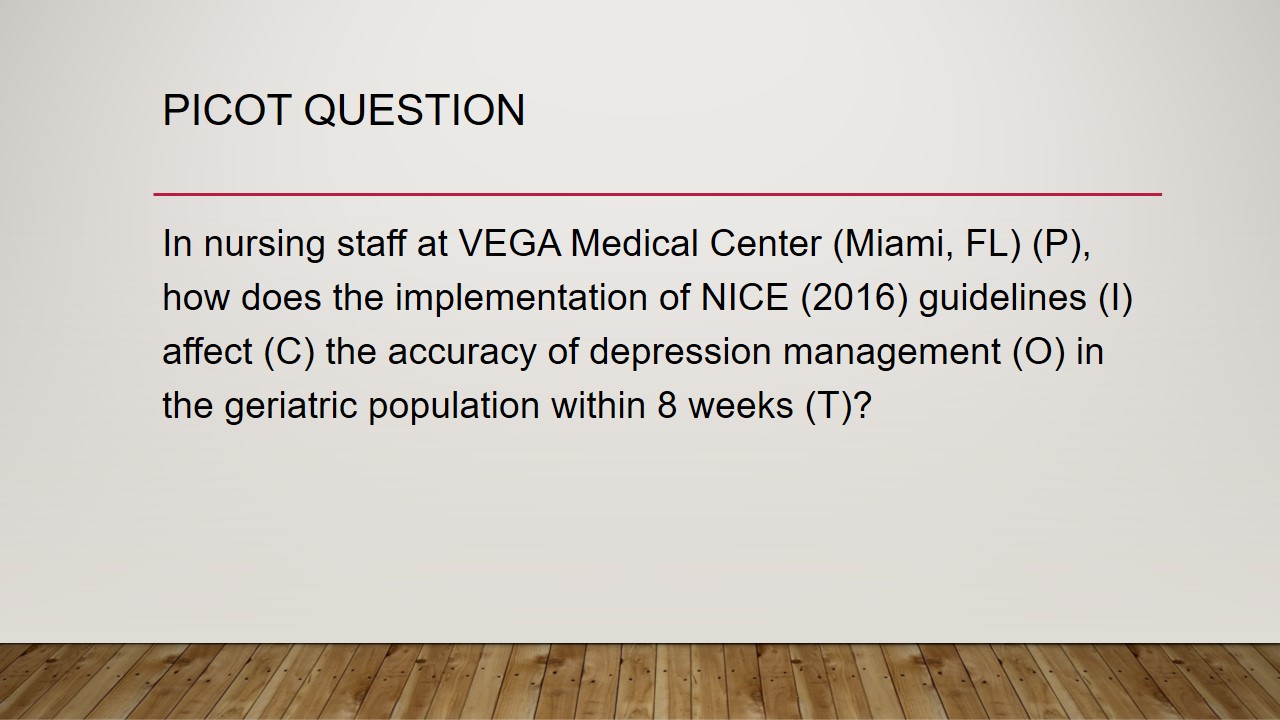
Theoretical Framework
Blend of change frameworks:
- Iowa Model of Evidence‐Based Practice (Iowa Model Collaborative, 2017): major steps.
- Kotter’s (2012) 8-step change model: leadership activities.
- Rogers’ (2010) innovation attributes: individual change management.
Since the project consisted of a change, its theoretical framework was comprised of change frameworks. In particular, the Iowa Model of Evidence‐Based Practice was used as the primary framework that can organize the entire project from its planning to information dissemination (Iowa Model Collaborative, 2017). The attention of the model on healthcare settings, change, and evidence-based practice introduction was considered its key advantage. Apart from that, Kotter’s (2012) 8-step change model and Rogers’ (2010) innovation diffusion theory (particularly, its part pertinent to innovation attributes) were integrated into the Iowa model to ensure the sustainability of the project. Kotter’s (2012) model provided the framework for leading the change, and Rogers’ (2010) theory introduced a model for individual change management. The resulting framework combined the positive features of every of the mentioned models.
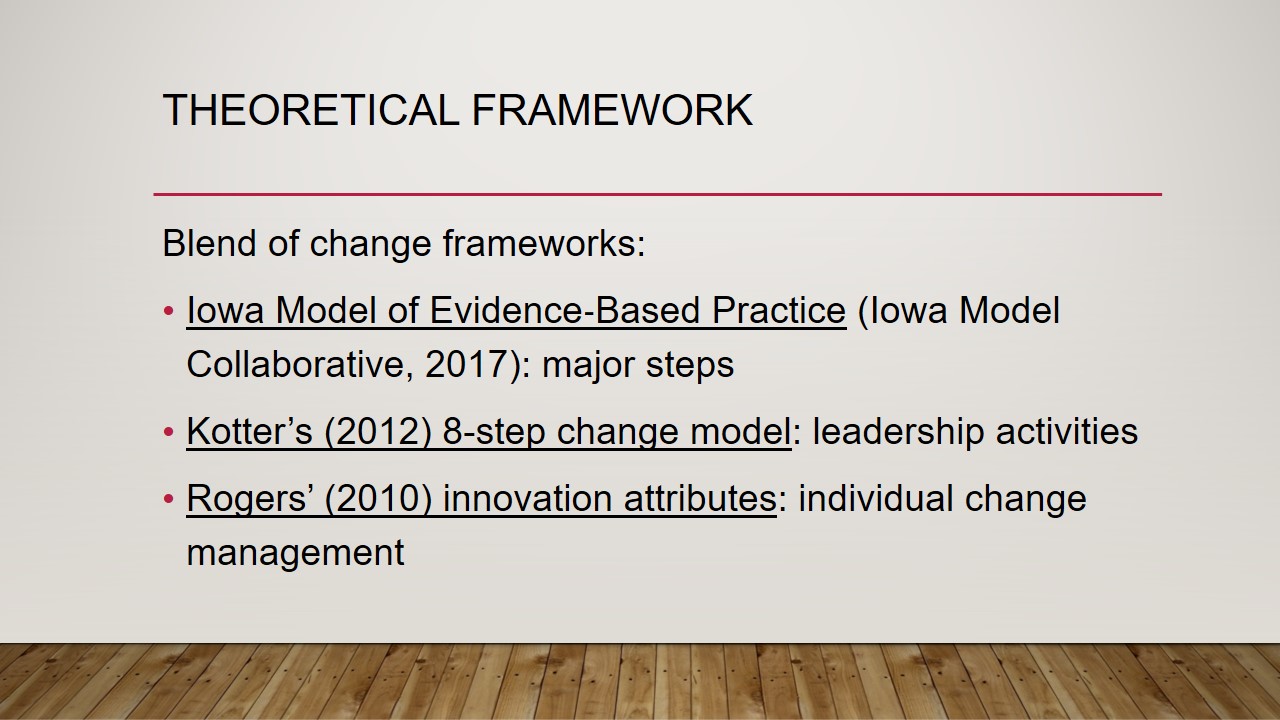
Project Design -Methodology
- Settings: VEGA Medical Center (Miami, FL):
- Barriers: resistance to change, adoption period;
- Facilitators: culture, stakeholders, alignment;
- Final sample: 10 nurses;
- Sampling: purposive, flyers;
- Design: pre/posttest mixed methods study;
- Quantitative data collection: NICE (2017) quality standards:
- no exact validity/reliability data;
- Qualitative data collection: group interview guide:
- trialed and reviewed.
- Step 1: Week 1:
- Recruitment finalization;
- First group meeting: training, feedback;
- Step 2: Weeks 2-7:
- Work with patients;
- Performance recording: NICE (2017) standards;
- Meetings: feedback, sustainability-related efforts (models by Kotter (2012) and Rogers (2010) to manage concerns);
- Step 3: Week 8:
- Final meeting: drawing conclusions;
- Submitting performance reports.
- Summative evaluation:
- Eleven NICE (2017) quality indicators;
- Weeks 1 and 8;
- Secondary and primary data;
- Formative evaluation:
- Meetings (group interview guide);
- Weeks 1-8;
- Primary data.
The settings of the project should be briefly considered. VEGA is a primary care center that serves a diverse population, including geriatric patients and patients with depression. The settings were rather beneficial for the project; in particular, they had multiple facilitators, including all the stakeholders (managers and nurses), who were very supportive. Also, VEGA’s culture and vision and mission were in line with those of the project. The anticipated barriers included the resistance to change, which proved to be nearly non-existent and was prevented with the help of Kotter’s (2012) and Rogers’ (2010) models. Apart from that, the adoption period proved to be a barrier, but it was brought down with the help of training and the same models. The timeframe and budget were also initially viewed as a potential problem, but both proved to be sufficient.
The project engaged the total of ten nurses with the help of flyers; the nurses of VEGA center were purposefully approached.
The project took the form of a pre/posttest pilot change that used both qualitative and quantitative methods. In particular, NICE (2017) quality standards were employed to collect quantitative data for summative assessment, and a specifically developed interview guide provided the tool for qualitative formative assessment. According to NICE (2017), the quality standards are reliable and valid, but the present study failed to find the specific figures that would describe their validity and reliability. The permission to use the standards, as well as the guidelines, was obtained. The qualitative tool was developed specifically for the project and has no validity or reliability statements, but it was reviewed with the help of specialists and trialed to ensure that it performs its function. The tool was employed during the meetings that were carried out throughout the project.
The intervention itself was first introduced to the nurses during the first week of the project. After signing the informed consent forms and, therefore, finalizing the recruitment process, the nurses were provided with all the information about the guidelines, as well as the relevant tools (decision-making flowchart and quality standards), all of which are offered by NICE (2016) free of charge. After the initial discussion, which demonstrated the preliminary approval of the guidelines, the nurses returned to their duties, with which they proceeded throughout the 8 weeks of the project while also recording their performance with the help of the NICE (2017) standards.
Apart from that, the nurses participated in meetings every week. The latter used the before-mentioned interview guide to gather feedback, provide support and training, and ensure the sustainability of change with the help of the principles of the models by Kotter (2012) and Rogers (2010). Eventually, during the final week, the final meeting took place and demonstrated the success of the project, and the performance reports were submitted.
As it was mentioned, the project employed the NICE (2017) quality standards for summative evaluation during weeks 1 and 8. During the first week, the secondary data that was already available for the nurses was used, and during the final one, new data was collected. As for formative evaluation, the meetings played the role throughout the project, producing primary qualitative data.
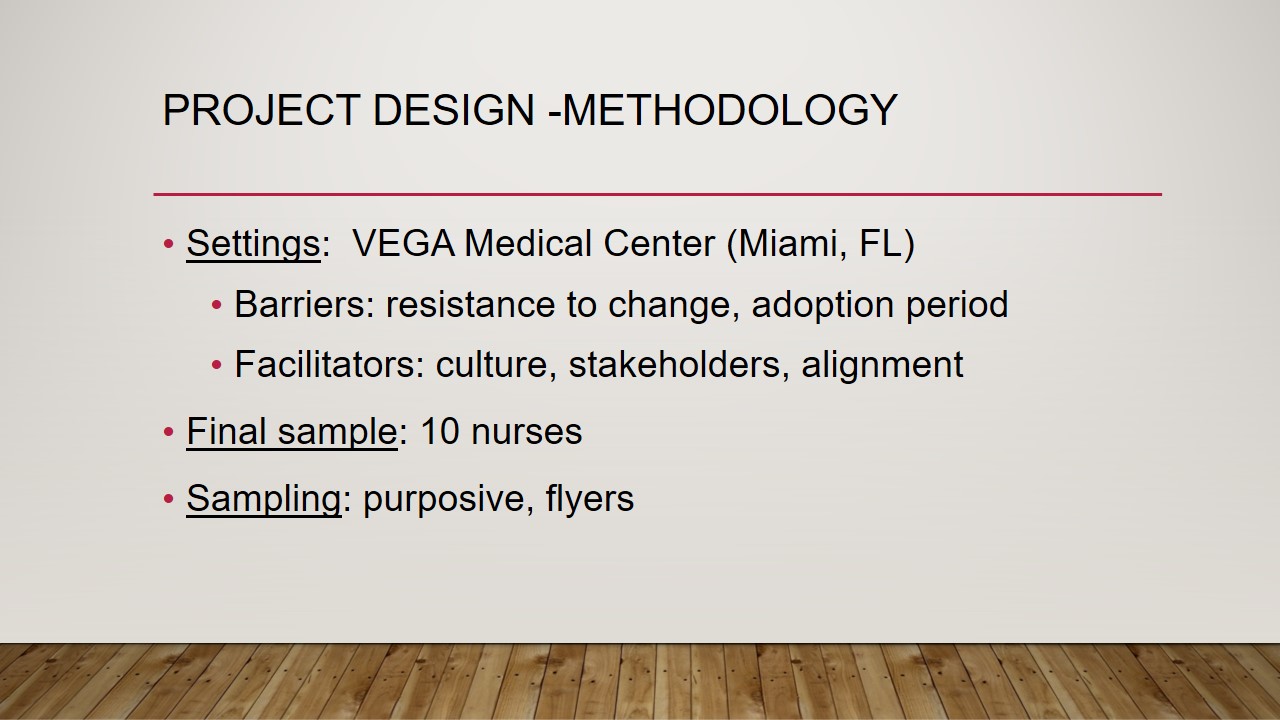
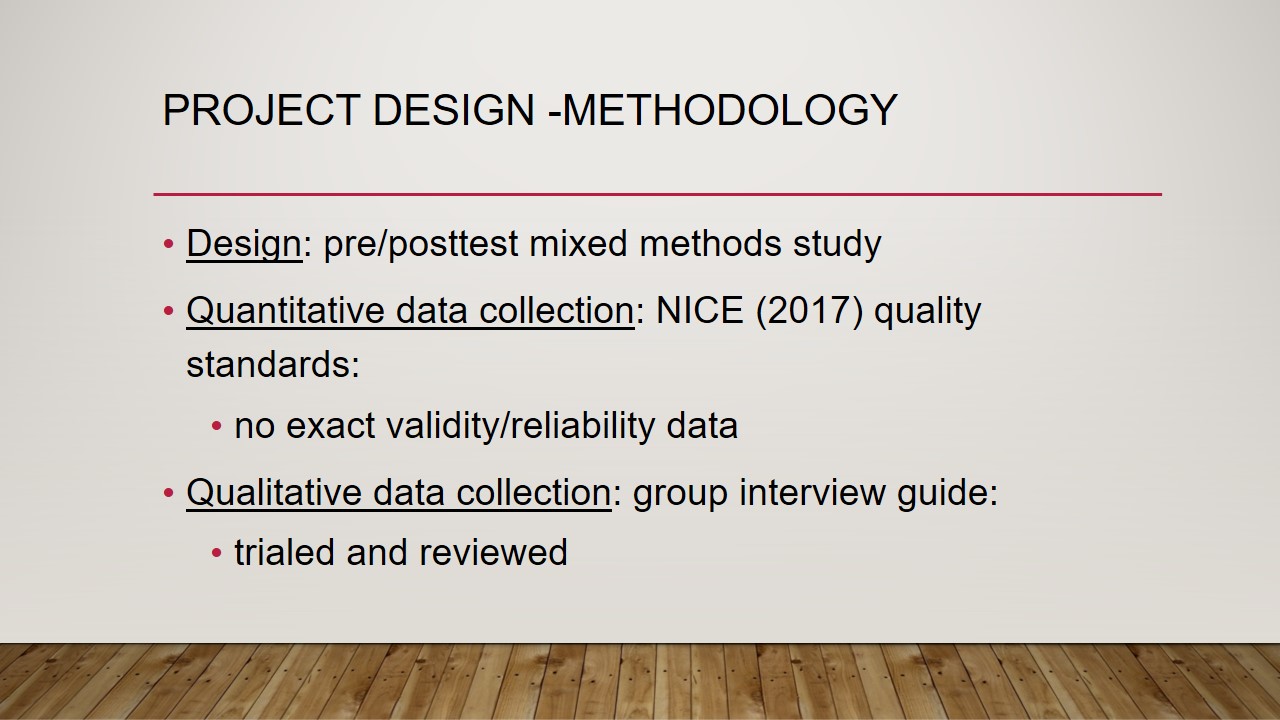
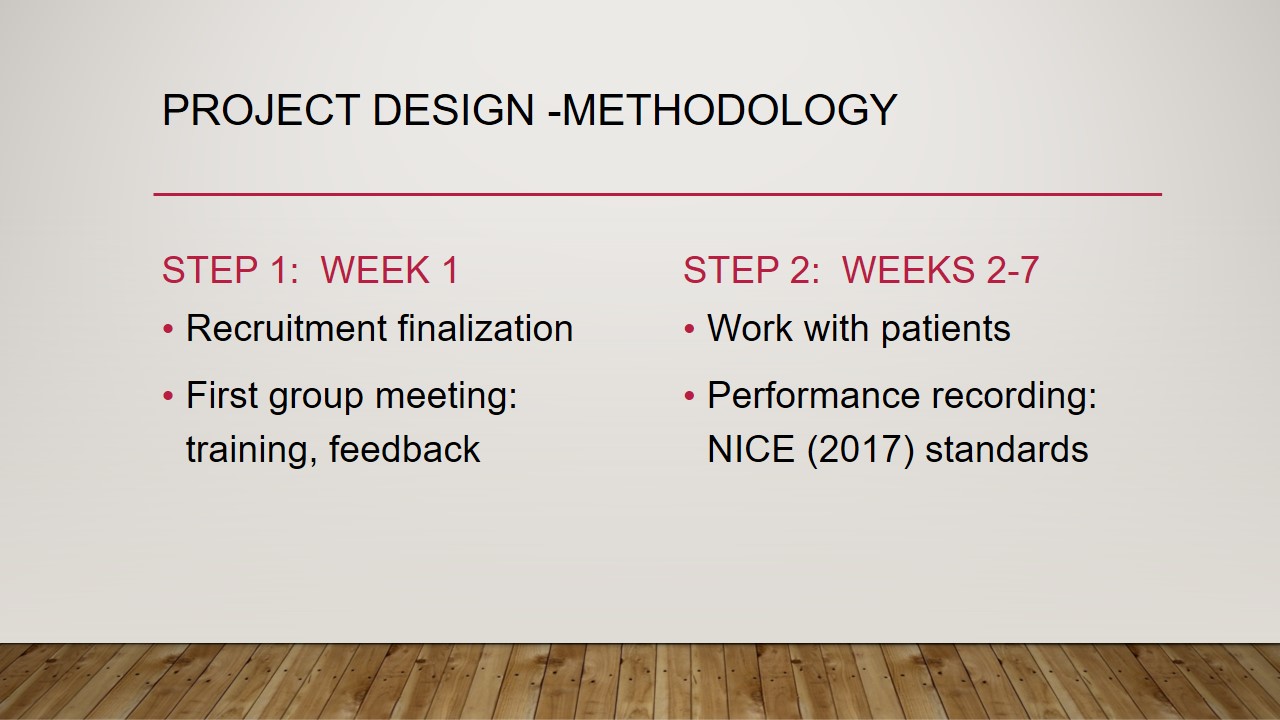
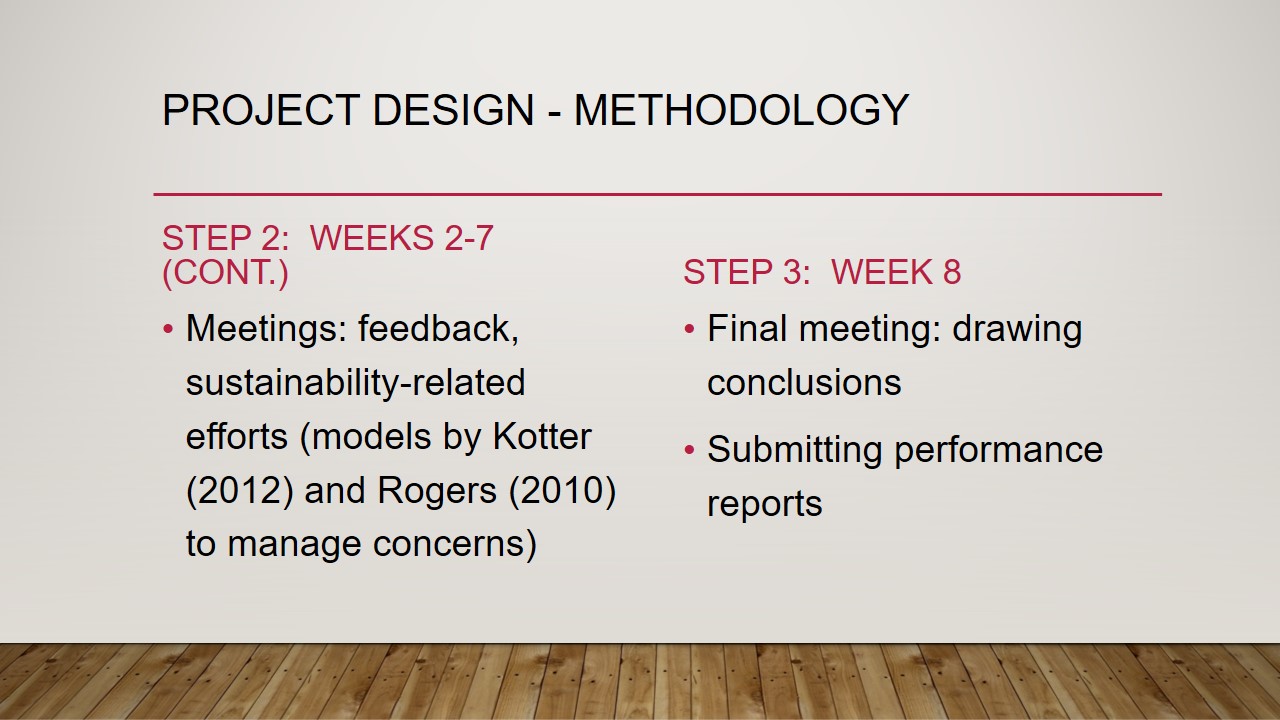
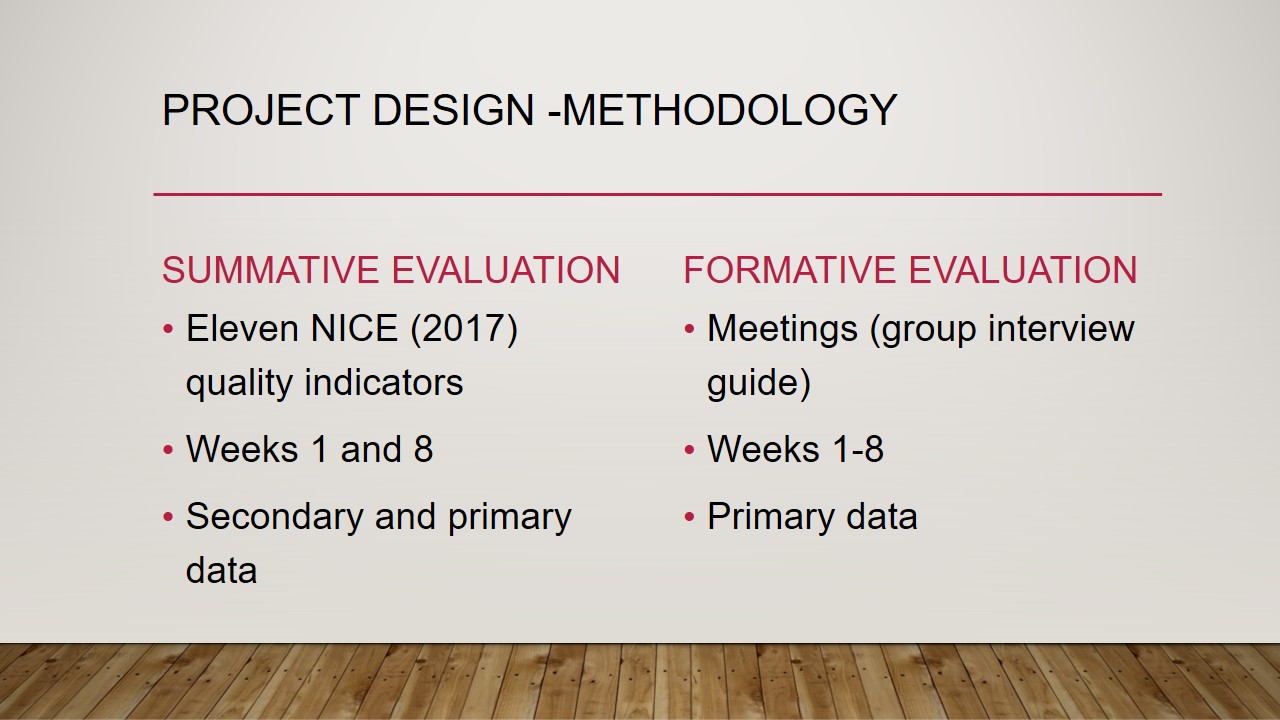
Evaluation – Analysis
- Summative evaluation:
- NICE (2017) indicators;
- Quantitative data;
- SPSS: sign test (Frey, 2018);
- Extraneous variable: justified non-compliance;
- Formative evaluation:
- Meetings (group interview guide);
- Qualitative data;
- Thematic analysis (Polit & Beck, 2017).
The analysis of the data was conducted accordingly. Thematic analysis was applied to qualitative data, which is a relatively common approach for this type of information (Polit & Beck, 2017). The quantitative summative evaluation was carried out with the help of SPSS and sign test, which was employed because it is a non-parametric test that works with non-normally distributed data and can be used for a pre/posttest study (Frey, 2018). Here, it should be mentioned that the quality standards by NICE (2017) are more rigid than its guidelines. As a result, the extraneous variable of reasonable non-compliance was introduced: such cases were not viewed as non-compliance if they could be explained with the help of the guidelines.

Results
By the end of the project:
- 100% compliance (except for reasonable non-compliance)
- 100% approval of nurses
- No issues with usage
The following results can be reported. Each of the nurses had between 16 and 21 patients, but most quality indicators were applicable to fewer patients. For example, some of the standards describe the management of mild depression, and other ones are concerned with severe depression. Statistically significant changes were observed for Quality Standard 1 (assessment in accordance with NICE (2016) guidelines), Quality Standard 2a (depression management in accordance with NICE (2016) guidelines), and Quality Standard 11 (monitoring patients treating with pharmacotherapy in accordance with NICE (2016) guidelines). You can see the results for the first two standards. Note that the performance of the nurses with respect to these standards was relatively high pre-intervention. That was true for most quality indicators.
The Quality Standard 11 is presented as well. Note that the Quality Standard refers to a specific monitoring procedure not employed by VEGA before the introduction of the guidelines, which explains the changes in the figures.
However, as was shown during the interviews, the nurses approve of the new guidelines, and by the end of the project, 100% compliance was achieved with the exception of reasonable non-compliance. Similarly, the final meeting showed that by the end of the project, the nurses had brought down all the barriers, including the adjustment period, and had successfully adopted the guidelines.
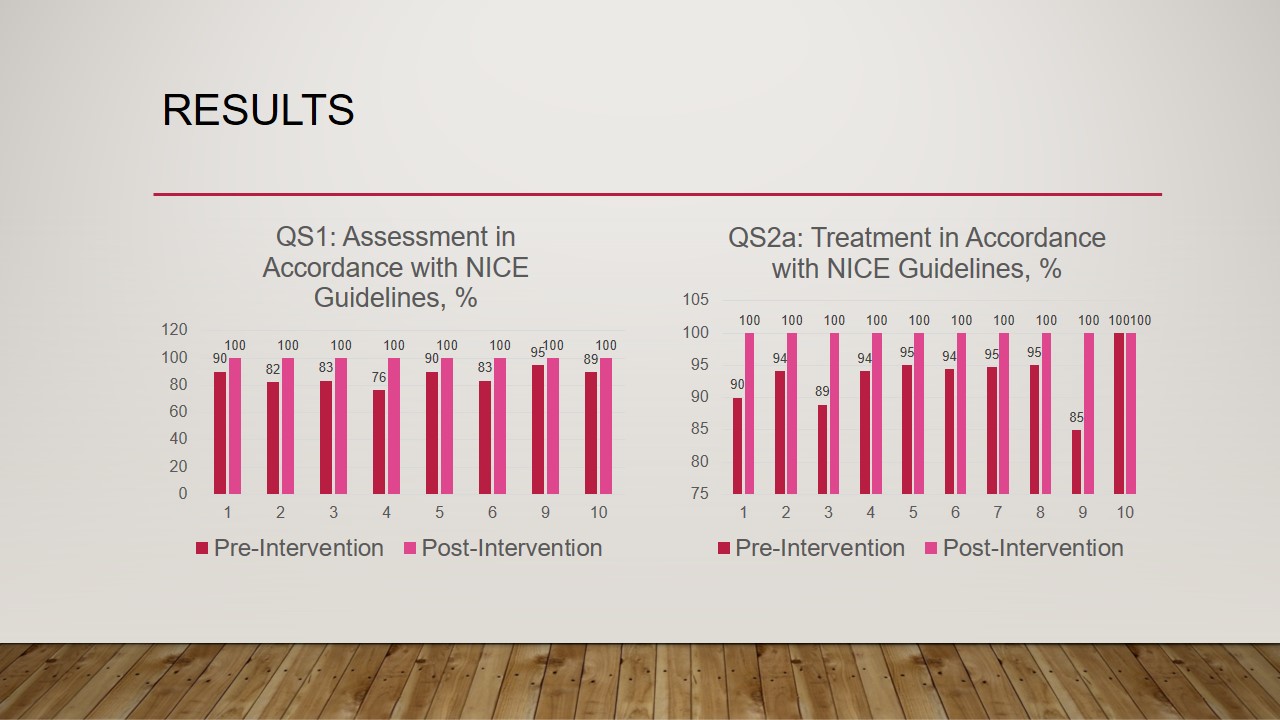

Sustainability
- Kotter’s (2012) and Rogers’ (2010) principles.
- Nurses’ approval.
- Positive outcomes.
- Data for future change.
- Barriers:
- Adjustment period;
- Training;
- Resources (time, effort);
- Lower speed;
- Facilitators:
- Appropriate guidelines;
- NICE materials;
- Training/recapping;
- Support.
Thus, the guidelines have the nurses’ approval, and the project had demonstrated some positive outcomes while also providing some data on the processes of change, barriers, and facilitators that can be used by VEGA for future changes. The positive outcomes of the project may be connected to its management with the help of Kotter’s (2012) and Rogers’ (2010) models. All these features seem to suggest that the project can be sustainable.

Implications for Practice
- Proceeding with the change seems reasonable:
- NICE (2016) can improve quality at VEGA;
- Nurses approve of the guidelines;
- Future change: data on guideline adoption (barriers, facilitators);
- Future research: larger sample.
Important limitations of the study include the sample size and the lack of definite statements regarding the reliability and validity of the tools. Still, as a pilot change, the project has fulfilled its purpose: it showed that proceeding with the change appears reasonable since some statistically meaningful quality improvements are visible. Apart from that, the nurses are satisfied with the guidelines. The results cannot be generalized due to the small sample, but for the chosen microsystem, the decision to proceed with the change seems appropriate. Moreover, the study supplies some data for future change (for example, regarding the settings’ facilitators), and said change with a larger sample could also be used to produce more generalizable data concerning the effectiveness of the guidelines.
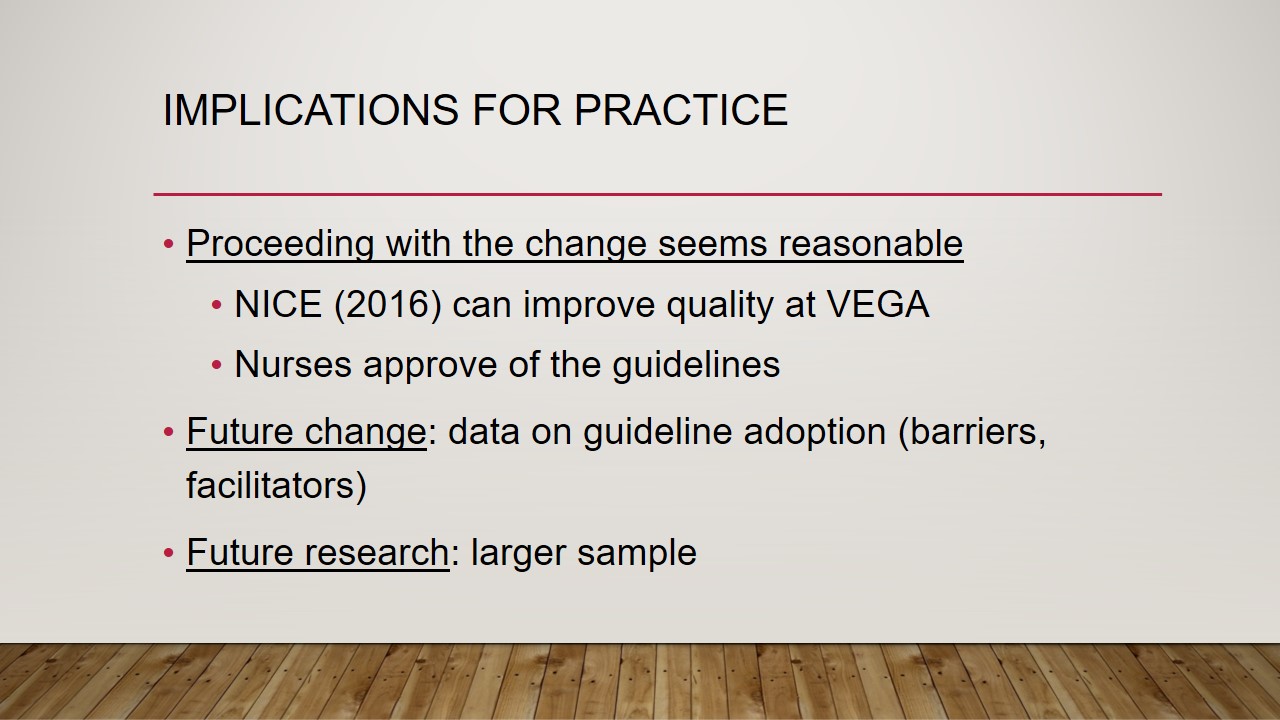
Conclusion
- Pre/posttest mixed methods study; 10 nurses;
- NICE (2017) standards and specifically developed interview guide;
- Iowa, Kotter’s (2012), and Rogers’ (2010) models;
- NICE (2016) guidelines can improve depression management at VEGA;
- Future research with bigger samples.
In summary, the presented pre/posttest mixed methods study recruited 10 nurses from VEGA for a pilot change involving the implementation of NICE (2016) guidelines. It used NICE (2017) standards along with a specifically developed interview guide for evaluation. The project proved to be successful, demonstrating that NICE (2016) guidelines can result in quality improvement and are also favored by its nurses. Therefore, proceeding with the change seems reasonable, but future research with a larger sample could produce more generalizable results.
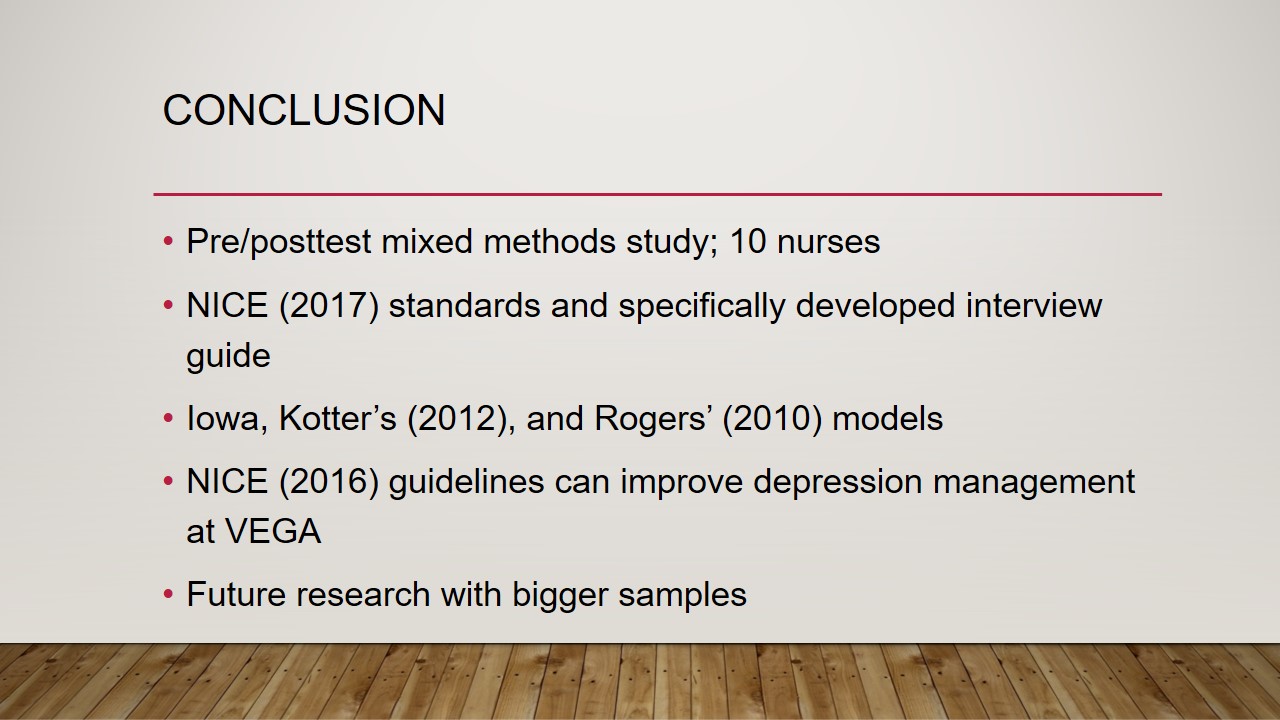
Acknowledgements
- Dr. Pedro Martinez, my preceptor;
- Managers, nurses, and staff of VEGA.
I would also like to thank the people who contributed to the development of this work. The support and feedback of my preceptor Dr. Pedro Martinez and the hard work of VEGA’s managers, nurses, and staff made this project possible.
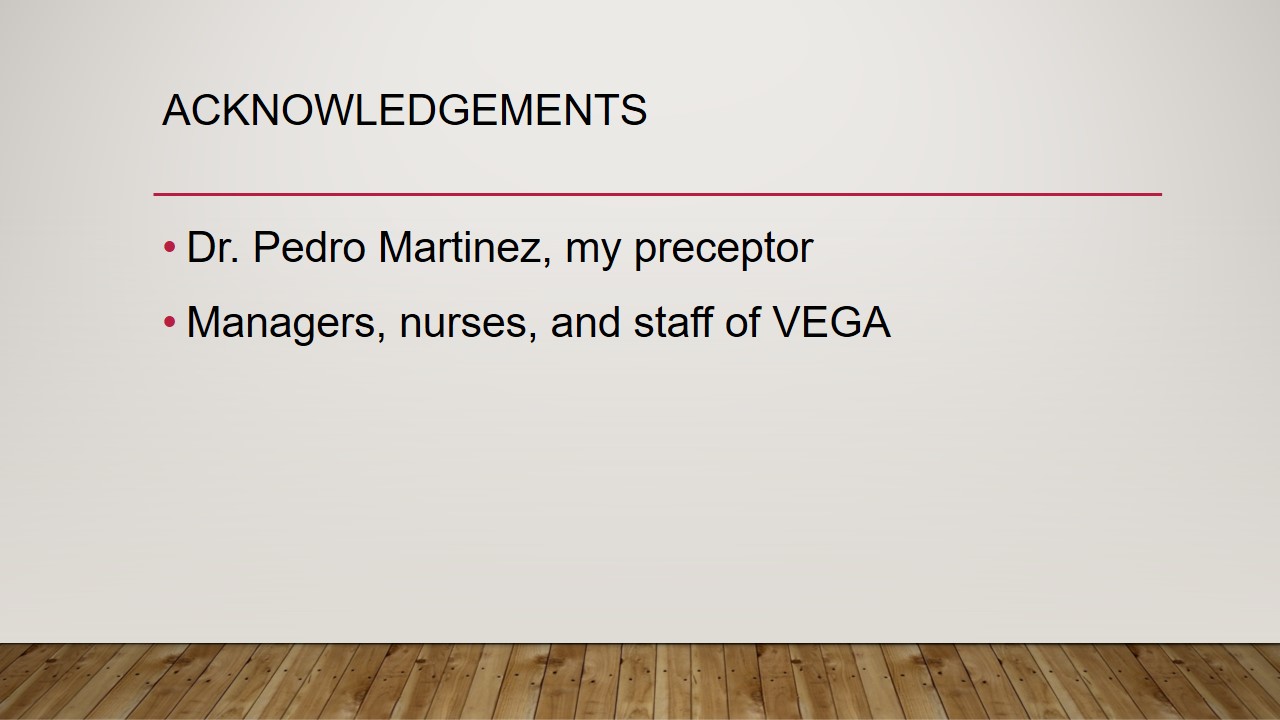
References
CBHSQ. (2016). Results from the 2015 national survey on drug use and health: Detailed tables. Web.
Frey, B. (2018). The SAGE encyclopedia of educational research, measurement, and evaluation (Vols. 1-3). Thousand Oaks, CA: SAGE Publications.
Kotter, J. (2012). Leading change. Boston, MA: Harvard Business School Press.
NICE. (2016). Depression in adults: Recognition and management. Web.
NICE. (2017). Depression in adults: Quality Standards. Web.
Petrosyan, Y., Sahakyan, Y., Barnsley, J., Kuluski, K., Liu, B., & Wodchis, W. (2017). Quality indicators for care of depression in primary care settings: A systematic review. Systematic Reviews, 6(1), 1-14. Web.
Polit, D.F., & Beck, C.T. (2017). Nursing research: Generating and assessing evidence for nursing practice (10th ed.). Philadelphia, PA: Lippincott, Williams & Wilkins.
Rogers, E.M. (2010). Diffusion of innovations (4th ed.). New York, NY: Simon and Schuster.